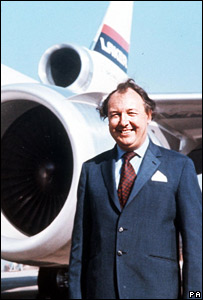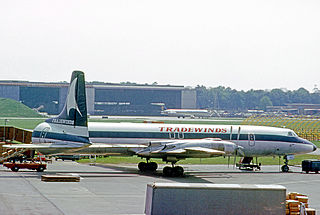
Sir Frederick Alfred Laker was an English airline entrepreneur, best known for founding Laker Airways in 1966, which went bankrupt in 1982. Known as Freddie Laker, he was one of the first airline owners to adopt the "low cost / no-frills" airline business model that has since proven to be successful worldwide when employed by companies such as Ryanair, Southwest Airlines, easyJet, Norwegian Air, and AirAsia.

Berlin Tegel "Otto Lilienthal" Airport was the primary international airport of Berlin, the capital of Germany. The airport was named after aviation pioneer Otto Lilienthal and was the fourth busiest airport in Germany, with over 24 million passengers in 2019. In 2016, Tegel handled over 60% of all airline passenger traffic in Berlin. The airport served as a base for Eurowings, Ryanair and easyJet. It featured flights to several European metropolitan and leisure destinations as well as some intercontinental routes. It was situated in Tegel, a section of the northern borough of Reinickendorf, eight kilometres northwest of the city centre of Berlin. Tegel Airport was notable for its hexagonal main terminal building around an open square, which made walking distances as short as 30 m (100 ft) from the aircraft to the terminal exit.
British Caledonian (BCal) was a private independent airline in the United Kingdom that operated from 1970 until it merged with British Airways in 1988. It operated primarily from London Gatwick Airport in south-east England. BCal was formed by the merger of Caledonian Airways and British United Airways (BUA). It was created as an alternative to the British government-controlled corporation airlines and was described as the "Second Force" in the 1969 Edwards report. The carrier slogan was Let's go British Caledonian in the 1970s and We never forget you have a choice in the 1980s. The BUA takeover enabled Caledonian to realise its long-held ambition to transform itself into a scheduled airline. The merged entity eventually became the UK's foremost independent, international scheduled airline.

Caledonian Airways was a wholly private, independent charter airline in the United Kingdom formed in April 1961. It began with a single 104-seat Douglas DC-7C leased from the Belgian flag carrier Sabena. Caledonian grew rapidly over the coming years to become the leading transatlantic "affinity group" charter operator by the end of the decade. During that period, passenger numbers grew from just 8,000 in 1961 to 800,000 in 1970. The latter represented 22.7% of all British non-scheduled passengers. It also became Britain's most consistently profitable and financially most secure independent airline of its era, never failing to make a profit in all its ten years of existence. By the end of 1970, Caledonian operated an all-jet fleet consisting of eleven aircraft and provided employment for over 1,000 workers. At that time, its principal activities included group charters between North America, Europe and the Far East using Boeing 707s, and general charter and inclusive tour (IT) activities in Europe utilising One-Elevens.
Pacific Western Airlines Ltd (PWA) was an airline that operated scheduled flights throughout western Canada and charter services around the world from the 1950s through the 1980s.

Dan-Air was an airline based in the United Kingdom and a wholly owned subsidiary of London-based shipbroking firm Davies and Newman. It was started in 1953 with a single aircraft. Initially, it operated cargo and passenger charter flights from Southend (1953–1955) and Blackbushe airports (1955–1960) using a variety of piston-engined aircraft before moving to a new base at Gatwick Airport in 1960, followed by expansion into inclusive tour (IT) charter flights and all-year round scheduled services. The introduction of two de Havilland Comet series 4 jet aircraft in 1966 made Dan-Air the second British independent airline after British United Airways to begin sustained jet operations.
British Airtours was a charter airline in the United Kingdom with flight operations out of London Gatwick and Manchester Airports.
AirUK was a wholly privately owned, independent regional airline in the United Kingdom formed in 1980 as a result of a merger involving four rival UK-based regional airlines. British and Commonwealth (B&C)-owned British Island Airways (BIA) and Air Anglia were the two dominant merger partners. The merged entity's corporate headquarters were originally located at Redhill, Surrey, the location of the old BIA head office. It subsequently relocated to Crawley, West Sussex. In addition to the main maintenance base at Norwich Airport, there also used to be a second major maintenance base at Blackpool Airport. This was closed down following Air UK's major retrenchment during Britain's severe recession of the early 1980s. In 1987, Air UK established Air UK Leisure as a charter subsidiary. The following year, Air UK shifted its headquarters to London Stansted Airport. When Stansted's new Norman Foster-designed terminal opened in 1991, the airline became its first and subsequently main tenant.

Laker Airways was a private British airline founded by Sir Freddie Laker in 1966. It was originally a charter airline flying passengers and cargo worldwide. Its head office was located at Gatwick Airport in Crawley, England.

British United Airways (BUA) was a private, independent airline in the United Kingdom formed as a result of the merger of Airwork Services and Hunting-Clan Air Transport in July 1960, making it the largest wholly private airline based in the United Kingdom at the time. British and Commonwealth Shipping (B&C) was the new airline's main shareholder.

British Island Airways (BIA) was the legal successor to British United Island Airways (BUIA). It commenced operations under that name in mid-1970. Ten years later it merged with Air Anglia, Air Wales and Air Westward to form Air UK, at the time the United Kingdom's biggest regional airline and its third-largest scheduled operator. The first British Island Airways had its head office at Congreve House (1970–1972) and Berkeley House (1973–1979), which are respectively located in Station Road and on the high street in Redhill, Surrey.

The 1977 Dan-Air/IAS Cargo Boeing 707 crash was a fatal accident involving a Boeing 707-321C cargo aircraft operated by Dan Air Services Limited on behalf of International Aviation Services Limited, which had been sub-contracted by Zambia Airways Corporation to operate a weekly scheduled all-cargo service between London Heathrow and the Zambian capital Lusaka via Athens and Nairobi. The aircraft crashed during approach to Lusaka Airport, Zambia, on 14 May 1977. All six crew members of the aircraft were killed.
British United Air Ferries (BUAF) was a wholly private, British independent car and passenger ferry airline based in the United Kingdom during the 1960s. It specialised in cross-Channel ferry flights carrying cars and their owners between its numerous bases in Southern England, the Channel Islands and Continental Europe. All-passenger and all-cargo flights were operated as well. Following several identity and ownership changes, it went out of business in 2001.

British Eagle International Airlines was a major British independent airline that operated from 1948 until it went into liquidation in 1968. It operated scheduled and charter services on a domestic, international and transatlantic basis over the years.
Lloyd International Airways Ltd was a private, British independent airline formed in 1961 to operate worldwide charter flights. It commenced operations with a single Douglas DC-4 piston airliner from Cambridge Marshall Airport. Lloyd International concentrated on passenger and cargo charters with four-engined, long-range aircraft. It also had links in Hong Kong since its inception and flew to the Far East regularly. During the mid-1960s, the airline began re-equipping its fleet with Bristol Britannia and Canadair CL-44 turboprops, all of which featured large cargo doors and palletised freight systems. Long-range Boeing 707 jets joined the Lloyd International fleet during the early 1970s for use on affinity group passenger and freight charters to North America and the Far East. Lloyd International ceased operations in June 1972.

British airline British Caledonian (BCal) suffered a series of major setbacks in the 1980s as a result of several geopolitical events that occurred during that decade. These events significantly weakened BCal operationally and financially. They were the main factors that contributed to the airline's demise in 1988.
British Caledonian (BCal) came into being in November 1970 when the Scottish charter airline Caledonian Airways, at the time Britain's second-largest, wholly privately owned, independent airline, took over British United Airways (BUA), then the largest British independent airline as well as the United Kingdom's leading independent scheduled carrier.
Dan Air Engineering Limited was the maintenance arm of Dan Air Services Limited, itself a subsidiary of Davies and Newman, one of Britain's foremost wholly privately owned, independent ship broking and airline companies during the 1970s and 80s.

Tradewinds Airways Ltd was a British all-cargo airline. Its head office was located in Timberham House, on the property of London Gatwick Airport in Crawley, England.
Skyways Limited was an early post-World War II British airline formed in 1946 that soon became well-established as the biggest operator of non-scheduled air services in Europe.












